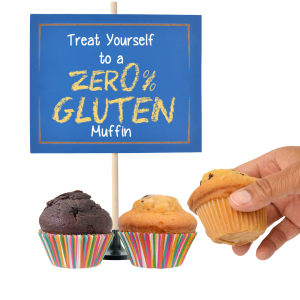The Diet That’s Trendy…But Maybe Also Health-Harmful?
The gluten free diet has been trendy for years now. All over the world, people have been ditching gluten, hoping to lose weight and live healthier lives. However, this diet isn’t for everyone and it could even be causing harm, along the lines of gut microbial imbalances and nutrient deficiencies.
Gluten is a mixture of proteins (glutenin and gliadin) found in wheat and several other grains, including barley and rye. It acts as a binding agent, giving elasticity and structure to dough and helping it rise. The word “glūten” itself comes from the Latin verb “glūtō,” meaning “to glue” or “to stick together.” This glue-like action is responsible for the chewy texture of bread and other baked goods. It’s also why it makes a great lickable envelope and stamp adhesive!

Individuals with Celiac disease, an autoimmune disorder triggered by the ingestion of gluten, must avoid gluten at all costs. In these individuals, the immune system reacts vehemently to gluten proteins, destroying the nutrient-absorbing portion of the lining of the small intestines (villi), damaging the mucus lining protecting the intestinal cells, and interfering with nutrient absorption. If you’d like to learn more about celiac disease, check out our blog.
Additionally, some people may have non-celiac gluten sensitivity. They experience digestive and/or other symptoms that may appear unrelated, but which resolve upon a gluten-free diet. These folks do not incur intestinal damage from the gluten, and may not need to be as strict as those with celiac.
Some people are additionally allergic to wheat and would also benefit from a gluten-free diet.
However, for the general population, the absence of gluten alone does not directly contribute to overall health. And in fact, a long term gluten free diet can cause gut microbiota disruption and nutrient deficiencies.
Here are a couple reasons why going gluten-free might affect the microbiome:
- When someone adopts a gluten-free diet, they eliminate gluten containing whole grains such as wheat, barley, and rye that are naturally rich in fiber. This dietary change can alter the composition of the gut microbiota because certain microorganisms feed on the carbohydrates present in whole grains. The reduction in these food sources may lead to a decrease in specific microbial populations resulting in a decrease of microbial diversity.
- Gluten-free grains in baked goods often are not whole grains, and so these carbs and their impact are altered. Prebiotics are a class of fiber that feed beneficial gut bacteria. Wheat and other gluten-containing grains are rich in prebiotics, such as beta glucans, fructans, and arabinoxylan. These prebiotics are found in different composition in other gluten-free grains, and are not as abundant. In eliminating gluten, prebiotic intake decreases, which decreases the growth and activity of beneficial gut bacteria, allowing their opportunistic, more inflammatory-promoting microbial counterparts to thrive. Additionally, we can see an overall reduction of different outputs from the good bacteria, especially including butyrate. Butyrate is an anti-inflammatory molecule in the gut and also feeds our intestinal cells.
- In addition to altering the gut bacteria, individuals following a gluten-free diet commonly do not consume adequate amounts of vitamins and minerals, particularly vitamin D, vitamin B12, folate, iron, magnesium, calcium, and zinc. This is not only because wheat does contain a number of vitamins and minerals, but also because in ithe United States, non-organic flour is required to be fortified by law. This means the government mandates that vitamins and minerals be added to wheat flour, and a good proportion of Americans then receive the bulk of these vitamins and minerals from eating wheat products.
The risk of nutrient deficiencies is even greater if gluten-containing refined foods such as breads, pastas, and cookies are swapped out with highly refined gluten-free alternatives. A gluten free cookie or pancake isn’t anymore nutritious than a regular gluten containing pancake or cookie. And, actually, gluten-free baked goods can be less nutritious, as carb-rich starches and poor quality oils are often used to mimic the textures of a gluten-containing baked item. Furthermore, as with any diet, convenience foods are often low in nutrition, high in calories, sugar and unhealthy fats, resulting in an overfed yet malnourished individual.

It is possible to have a healthy gluten-free diet that is rich in fruits, vegetables, legumes, nuts, and gluten-free grains such as quinoa and brown rice. When eating a well-rounded diet, a person following a gluten-free diet may not experience a reduction in nutrients and microbial diversity, though this is an area that our practice is beginning to more deeply explore in order to ensure that our gluten-free clients are getting what they need to thrive. It can also be helpful to screen nutrient status annually to adjust and modify the diet and supplement as needed.
